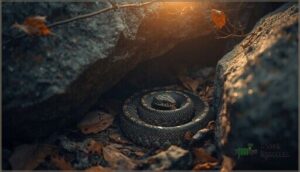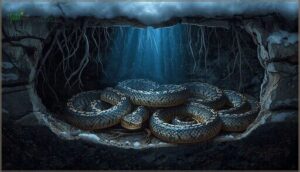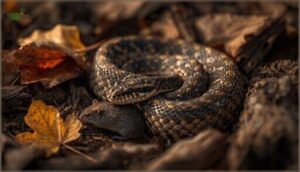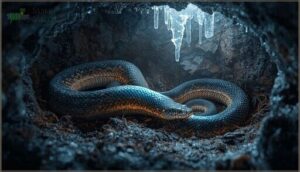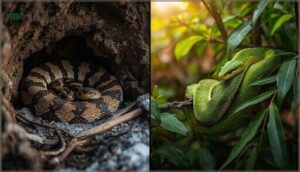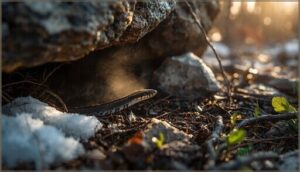This site is supported by our readers. We may earn a commission, at no cost to you, if you purchase through links.

Most temperate snake species disappear from view between late September and early November, retreating underground as temperatures drop and daylight shortens. This dormancy period, technically called brumation rather than true hibernation, represents one of nature’s most extraordinary survival strategies, allowing cold-blooded reptiles to endure months of freezing conditions with minimal energy expenditure.
The exact timing varies dramatically based on your geographic location, local climate patterns, and even the specific species in your area, with northern populations entering dormancy weeks or even months before their southern counterparts.
Understanding when snakes go into hibernation helps you predict seasonal activity patterns, recognize the environmental triggers that drive this behavior, and appreciate the complex physiological changes that enable these resilient creatures to survive winter’s harshest conditions.
Table Of Contents
- Key Takeaways
- When Do Snakes Go Into Hibernation?
- What Triggers Snake Brumation?
- How Do Snakes Prepare for Hibernation?
- What Happens to Snake Physiology During Brumation?
- Do All Snake Species Hibernate?
- When Do Snakes Emerge From Hibernation?
- Frequently Asked Questions (FAQs)
- At what temperature do snakes become inactive?
- What month do snakes go away?
- How do you know if a snake is hibernating?
- What month do snakes brumate?
- Where do snakes go during the winter?
- What is the best time of day to avoid snakes?
- Do snakes hibernate in houses?
- Do snakes hibernate?
- When do rattlesnakes hibernate?
- When do grass snakes hibernate?
- Conclusion
Key Takeaways
- Most temperate snakes enter brumation between late September and early November when temperatures consistently drop below 60°F, though the exact timing varies significantly by geographic location, elevation, and species-specific cold tolerance.
- Snakes prepare for brumation by responding to environmental triggers including temperature thresholds around 60°F, decreasing daylight hours below 10 hours, and declining food availability, which prompt them to stop feeding and seek protected hibernacula like deep burrows or rock crevices.
- During brumation, snakes experience dramatic physiological changes including a 50-90% reduction in metabolic rate, heart rate dropping from 40-60 beats per minute to 10-20, and body temperature falling to match their surroundings at 5-15°C while maintaining minimal hydration through bodily reserves.
- Snakes emerge from brumation in March through May when spring temperatures consistently exceed 60-65°F, though this vulnerable transition period brings increased risks of dehydration, predation, and mortality as their digestive systems slowly readjust and energy replenishment occurs gradually.
When Do Snakes Go Into Hibernation?
The timing of brumation isn’t universal across all snakes, as it depends heavily on local climate patterns and each species’ natural adaptations. Most temperate snakes begin this dormant period somewhere between late September and early November, though the exact window shifts based on where they live.
Understanding the seasonal patterns, monthly variations, and regional differences helps you predict when snakes in your area will become less active. For example, reticulated pythons shift their behavior based on breeding cycles and temperature, as explained in this guide to reticulated python temperament.
Typical Seasonal Timing
Across temperate zones, snakes enter winter dormancy when fall temperatures signal survival mode. This seasonal pattern follows nature’s rhythms, with brumation duration spanning several months as reptile physiology responds to climate influences and temperature fluctuations. You’ll notice geographic variance shapes timing: During this time, their safe snake shedding assistance needs change dramatically as metabolic slowdown extends the molting cycle from days to weeks.
- Late fall entry (October–December) as food disappears
- Extended dormancy through winter’s coldest months
- Spring emergence (March–May) when warmth returns.
Scientists use methodological rigor to study these patterns.
Month-to-Month Variation
You’ll see timing shift by 1–2 months depending on where you’re. Northern regions often trigger winter dormancy earlier—September or October—while milder southern areas delay entry until November.
Elevation effects matter too: mountain snakes respond to ambient temperatures and seasonal cues weeks before lowland cousins. Timing this dormancy period right is crucial—understanding how snake brumation works as a natural process helps explain why elevation shapes these survival rhythms.
Year-to-year climate shifts and temperature fluctuations create additional variation, with warm spells sometimes postponing snake hibernation patterns by 2–4 weeks.
Geographic Differences by Region
Regional climate shapes snake hibernation patterns more than you might expect. Latitude effects push northern species into brumation by late fall, while tropical climates eliminate the need entirely.
Elevation impact means mountain populations brumate weeks earlier than lowland relatives.
Coastal variations moderate temperatures, delaying dormancy compared to inland areas. Captive corn snakes in milder climates may maintain steadier appetites through winter, though understanding their natural feeding rhythms helps owners recognize when reduced interest is normal.
Desert adaptations create irregular cycles—reptile ecology shows these snakes may stay active on warm winter days despite cooler nights.
What Triggers Snake Brumation?
Snakes don’t simply wake up one morning and decide it’s time to brumate. Their bodies respond to specific environmental signals that tell them winter is approaching and it’s time to prepare.
Snakes don’t decide to brumate—their bodies react to environmental signals that winter is coming
Understanding these triggers helps you recognize when snakes in your area are entering their dormant period and why they seem to disappear as the seasons change.
Temperature Thresholds (e.g., 60°F)
When do snakes start their winter dormancy? For many temperate species, the magic number hovers around 60°F. As an ectothermic reptile, your local snake relies on external heat to regulate its body temperature. For a deeper look at how long this dormancy lasts and what triggers it, check out this guide to snake brumation periods.
When nighttime lows consistently dip below this threshold for several weeks, brumation triggers kick in. Cold adaptation means their metabolism slows dramatically, signaling it’s time to seek shelter before temperature fluctuations make survival challenging.
Decreasing Daylight Hours
Beyond ambient temperature alone, photoperiod cues play a key role in brumation timing. As day length shortens to around 10 hours or less in late autumn, your local snake’s internal clock recognizes the seasonal trigger.
This light cycle shift—dropping a few minutes daily—signals approaching winter more reliably than temperature fluctuations, prompting reptile behavior changes that prepare the animal for dormancy and winter survival.
Understanding the impact of light cycles is essential for grasping snake behavior and physiology.
Food and Water Availability
When prey scarcity sets in and water sources freeze, you’ll find snakes shifting toward dormancy. Before entering brumation, they stop eating to clear their digestive system, as ectothermic reptiles can’t process food with a slowed metabolic rate.
Dehydration risks prompt some species to drink heavily beforehand, relying on nutrient storage and energy conservation strategies fundamental to wildlife biology and winter survival.
How Do Snakes Prepare for Hibernation?
Snakes don’t just slip into brumation overnight—they follow a careful sequence of behavioral adjustments that prepare them for months of dormancy. You’ll notice changes in their activity patterns, feeding habits, and movement as temperatures drop and daylight fades.
Understanding these preparatory stages helps you recognize what’s happening when wild snakes seem to disappear from their usual territories.
Behavioral Changes Before Brumation
As temperatures begin their autumn decline, you’ll notice snakes becoming quieter, almost as if they’re winding down a clock. These ectothermic creatures reduce daytime activity considerably, spending more time tucked into tight crevices and insulated spots.
Pre-brumation behavior includes foraging cessation and fewer responses to environmental cues around them. Activity reduction signals their preparation for hibernation, a necessary shift before full brumation takes hold.
Habitat Selection and Hibernacula
Once foraging winds down, your attention should turn to where these animals shelter. Snakes choose hibernacula—specialized winter refuges like deep burrows, rock crevices, or caves—that stay above freezing and resist desiccation. Microhabitat selection depends on stable temperature, moisture retention, and insulation from harsh conditions.
Key hibernacula characteristics include:
- Protection from predators and extreme cold
- Thermal buffering through soil or rock layers
- Proximity to spring foraging areas
These ecological adaptations guarantee successful brumation and spring emergence.
Cessation of Feeding
Before your snake settles in for brumation, it stops eating—think of it as clearing the digestive tract for a long winter fast. Feeding patterns shift in late summer as temperatures drop, triggering energy conservation through metabolic slowdown.
An empty gut prevents rot during hibernation when coldblooded reptiles can’t digest food. This dietary preparation is essential for winter fasting survival.
What Happens to Snake Physiology During Brumation?
When a snake enters brumation, its body undergoes dramatic physiological changes that allow it to survive months without food or regular activity. These adaptations include significant reductions in metabolic rate, altered temperature regulation, and minimal but essential hydration needs.
Understanding these internal shifts helps you recognize what’s happening beneath the surface during this dormant period.
Metabolic Rate and Heart Rate Reduction
During brumation, your snake’s body shifts into energy conservation mode through striking physiological adaptation. This reptile physiology and behavior differs fundamentally from mammalian hibernation.
The metabolic slowdown includes:
- Metabolic rate plunges 50–90%, depending on species and ambient conditions
- Heart rate reduction drops from 40–60 beats per minute down to 10–20 during deeper torpor mechanisms
- Cellular maintenance continues at minimal levels
- Fat reserves fuel essential functions
- Coldblooded physiology synchronizes with environmental temperatures
Body Temperature Regulation
As this metabolic slowdown unfolds, your snake’s ectothermic responses mean its body temperature drops to match the surrounding environment—usually between 5–15°C in temperate species. Unlike warm-blooded animals, coldblooded animals like snakes rely on behavioral thermoregulation methods rather than internal heat production.
During brumation physiology, active temperature regulation largely stops, allowing stable, low body temperatures that align with cold adaptation strategies and minimize energy expenditure despite temperature fluctuations.
Hydration and Occasional Activity
While your snake’s body temperature sits steady in its hibernaculum, water balance becomes a quiet balancing act. Snake hydration during dormancy relies on bodily reserves and minimal osmotic exchange with moist microhabitats—no drinking required for most species.
You might spot occasional winter activity as your snake shifts position within its shelter, adjusting for comfort without fully waking, reflecting complex dormancy patterns shaped by brumation physiology.
Do All Snake Species Hibernate?
Not every snake species brumates, and the need for this dormancy period depends largely on where a snake lives and what temperatures it encounters throughout the year. Snakes native to temperate regions with cold winters usually brumate, while those from consistently warm tropical or subtropical climates often remain active year-round.
Understanding which species brumate and which don’t can help you better predict snake activity in your area and recognize the diverse ways these reptiles adapt to their environments.
Temperate Vs. Tropical Species
Where a snake lives shapes whether it’ll brumate at all. Temperate snakes enter true brumation during autumn and winter, slowing their metabolism drastically to survive freezing conditions and months-long food scarcity.
Tropical snakes rarely brumate, since warm climates keep them active year-round. When tropical species do show dormancy patterns, it’s usually brief and tied to dry seasons rather than cold—a fascinating example of climate adaptation and energetic tradeoffs across geographic variation.
Species-Specific Dormancy Patterns
Even within the same genus, you’ll find different dormancy patterns shaped by climate influence and geographic adaptation. North American rat snakes might brumate for several months in underground refugia, while European adders show longer brumation in northern populations compared to their milder southern relatives.
Species variation reflects each snake’s habitat—some choose deep soil burrows, others prefer communal rock crevices, demonstrating striking reptile hibernation diversity.
Examples of Non-Brumating Snakes
In tropical and subtropical regions, you’ll encounter species that skip brumation entirely. Sea snakes maintain year-round activity due to stable ocean temperatures, while many tropical colubrids never enter true dormancy.
Desert-adapted snakes in milder climates may remain active all winter if conditions stay favorable. These brumation exceptions showcase reptile hibernation diversity—some species with flexible strategies even continue limited activity when resources allow.
When Do Snakes Emerge From Hibernation?
Snakes emerge from brumation when environmental conditions signal that winter has passed and resources are available again. The timing depends on ambient temperature changes, geographic location, and the specific adaptations of each species.
Understanding when and how snakes exit dormancy helps you recognize their behavior patterns and the challenges they face during this vulnerable shift period.
Spring Temperature and Environmental Cues
You’ll notice snakes stirring when spring temperatures climb above 60–65°F for several consecutive days—this consistent warmth acts as nature’s wake-up call.
Thermal cues and seasonal shifts work together as environmental signals, prompting reactivation from snake hibernation. Climate patterns and temperature fluctuations also play roles in these ecological adaptations, with longer daylight periods reinforcing the message that it’s time to emerge and resume activity.
Post-Brumation Behavior and Risks
After brumation, your snake’s movements resume gradually as its body undergoes thermal acclimation, but this shift period brings real challenges.
Dehydration risks spike if water sources are scarce, making rehydration strategies essential for survival.
Energy replenishment occurs slowly while digestive systems readjust, and lingering lethargy can increase post-emergence mortality through heightened predator vulnerability—it’s a delicate balancing act for these cold-blooded reptiles.
Regional and Species Variations
Where you live shapes when snakes emerge from hibernation—species diversity and latitudinal gradients mean northern populations wake weeks later than southern cousins due to climate adaptation. Elevation effects matter too, with montane snakes facing longer reptile hibernation and dormancy periods than lowland relatives.
Geographic isolation creates unique animal adaptation to cold weather patterns, so understanding snake hibernation vs brumation timing requires knowing your local species and terrain.
Frequently Asked Questions (FAQs)
At what temperature do snakes become inactive?
Like a thermostat clicking off, most temperate snakes shut down around 60°F, with inactivity deepening as temperatures approach 50–55°F, though regional Cold tolerance and thermal regulation vary widely.
What month do snakes go away?
In temperate regions, you’ll find snakes disappearing between October and December as brumation begins, though the exact month depends on your local climate, elevation, and which species live nearby.
How do you know if a snake is hibernating?
You can tell if a snake is in brumation—like spotting a candle barely flickering—by observing no movement for weeks, sluggish responses to disturbance, shallow breathing, and its position in a protected, cold microhabitat.
What month do snakes brumate?
In temperate regions, snakes usually brumate from November through February, though timing varies by latitude and local climate.
Northern populations enter dormancy earlier, while southern species may begin brumation later or skip it entirely.
Where do snakes go during the winter?
During brumation, you’ll find snakes retreating to underground hibernation sites like rock crevices, rodent burrows, and hollow logs.
These hibernaculum locations provide stable temperatures and insulation, supporting winter survival strategies in cold climate regions.
What is the best time of day to avoid snakes?
You’ll encounter fewer snakes during the coolest parts of the day—early morning or late evening—since most species are active when temperatures warm up, especially during the warm season.
Do snakes hibernate in houses?
Snakes don’t exactly throw housewarming parties, but they’ll crash your basement if it beats the frozen tundra outside.
They’re seeking shelter, not true brumation—think opportunistic guests waiting out winter’s worst tantrums.
Do snakes hibernate?
Technically, no—snakes don’t hibernate like mammals do. Instead, they enter brumation, a cold-weather dormancy that slows metabolism and activity while allowing occasional movement during warmer spells for water or repositioning.
When do rattlesnakes hibernate?
Most rattlesnakes enter brumation from late November through January, depending on your location and elevation. They respond to falling temperatures and shorter days, seeking communal dens where temperatures remain stable above freezing.
When do grass snakes hibernate?
Grass snakes enter brumation between October and November across the UK and Europe when temperatures drop below 50–59°F. They emerge in March or April as spring warmth returns and prey becomes available again.
Conclusion
Understanding when snakes go into hibernation transforms you from a passive observer into someone who reads the landscape like a field guide. Temperature drops below 60°F, daylight shrinks, and suddenly the world shifts—snakes vanish underground, their metabolic engines slowing to a whisper.
You’ll now recognize the environmental cues that trigger brumation, anticipate seasonal encounters, and respect the delicate timing that governs these extraordinary survivors as they navigate winter’s unforgiving grip.


